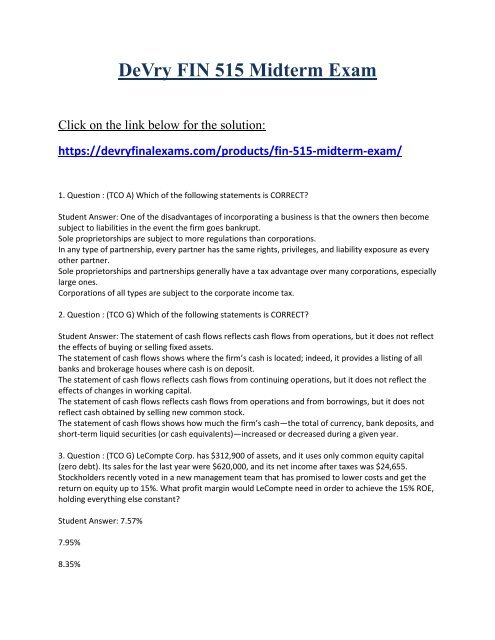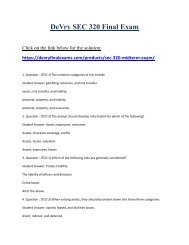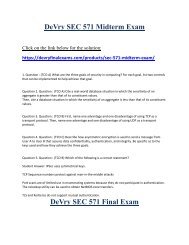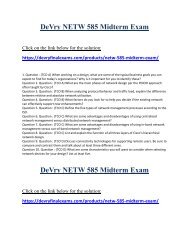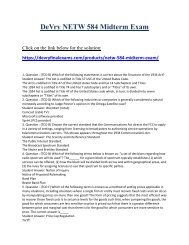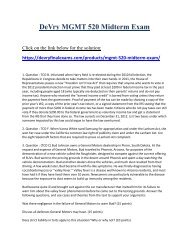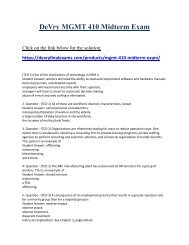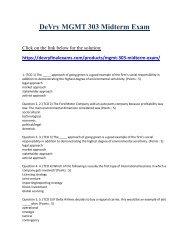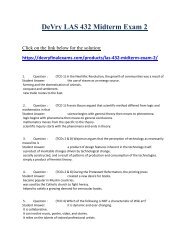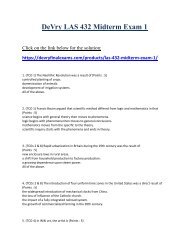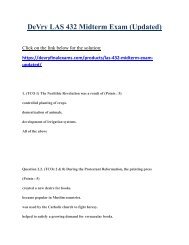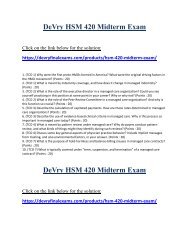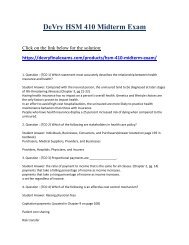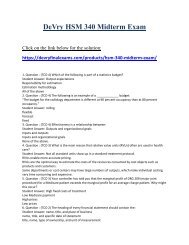FIN 515 Midterm Exam
Create successful ePaper yourself
Turn your PDF publications into a flip-book with our unique Google optimized e-Paper software.
DeVry <strong>FIN</strong> <strong>515</strong> <strong>Midterm</strong> <strong>Exam</strong><br />
Click on the link below for the solution:<br />
https://devryfinalexams.com/products/fin-<strong>515</strong>-midterm-exam/<br />
1. Question : (TCO A) Which of the following statements is CORRECT?<br />
Student Answer: One of the disadvantages of incorporating a business is that the owners then become<br />
subject to liabilities in the event the firm goes bankrupt.<br />
Sole proprietorships are subject to more regulations than corporations.<br />
In any type of partnership, every partner has the same rights, privileges, and liability exposure as every<br />
other partner.<br />
Sole proprietorships and partnerships generally have a tax advantage over many corporations, especially<br />
large ones.<br />
Corporations of all types are subject to the corporate income tax.<br />
2. Question : (TCO G) Which of the following statements is CORRECT?<br />
Student Answer: The statement of cash flows reflects cash flows from operations, but it does not reflect<br />
the effects of buying or selling fixed assets.<br />
The statement of cash flows shows where the firm’s cash is located; indeed, it provides a listing of all<br />
banks and brokerage houses where cash is on deposit.<br />
The statement of cash flows reflects cash flows from continuing operations, but it does not reflect the<br />
effects of changes in working capital.<br />
The statement of cash flows reflects cash flows from operations and from borrowings, but it does not<br />
reflect cash obtained by selling new common stock.<br />
The statement of cash flows shows how much the firm’s cash—the total of currency, bank deposits, and<br />
short-term liquid securities (or cash equivalents)—increased or decreased during a given year.<br />
3. Question : (TCO G) LeCompte Corp. has $312,900 of assets, and it uses only common equity capital<br />
(zero debt). Its sales for the last year were $620,000, and its net income after taxes was $24,655.<br />
Stockholders recently voted in a new management team that has promised to lower costs and get the<br />
return on equity up to 15%. What profit margin would LeCompte need in order to achieve the 15% ROE,<br />
holding everything else constant?<br />
Student Answer: 7.57%<br />
7.95%<br />
8.35%
8.76%<br />
9.20%<br />
4. Question : (TCO B) You deposit $1,000 today in a savings account that pays 3.5% interest,<br />
compounded annually. How much will your account be worth at the end of 25 years?<br />
Student Answer: $2,245.08<br />
$2,363.24<br />
$2,481.41<br />
$2,605.48<br />
$2,735.75<br />
5. Question : (TCO B) You sold a car and accepted a note with the following cash flow stream as your<br />
payment. What was the effective price you received for the car assuming an interest rate of 6.0%?<br />
Years: 0 1 2 3 4<br />
|———–|————–|————–|————–|<br />
CFs: $0 $1,000 $2,000 $2,000 $2,000<br />
Student Answer: $5,987<br />
$6,286<br />
$6,600<br />
$6,930<br />
$7,277<br />
6. Question : (TCO B) Suppose you borrowed $12,000 at a rate of 9.0% and must repay it in four equal<br />
installments at the end of each of the next four years. How large would your payments be?<br />
Student Answer: $3,704.02<br />
$3,889.23<br />
$4,083.69<br />
$4,287.87<br />
$4,502.26<br />
7. Question : (TCO D) Which of the following statements is CORRECT?
Student Answer: If a bond is selling at a discount, the yield to call is a better measure of return than the<br />
yield to maturity.<br />
On an expected yield basis, the expected capital gains yield will always be positive because an investor<br />
would not purchase a bond with an expected capital loss.<br />
On an expected yield basis, the expected current yield will always be positive because an investor would<br />
not purchase a bond that is not expected to pay any cash coupon interest.<br />
If a coupon bond is selling at par, its current yield equals its yield to maturity.<br />
The current yield on Bond A exceeds the current yield on Bond B; therefore, Bond A must have a higher<br />
yield to maturity than Bond B.<br />
8. Question : (TCO D) Garvin Enterprises’ bonds currently sell for $1,150. They have a six-year maturity,<br />
an annual coupon of $85, and a par value of $1,000. What is their current yield?<br />
Student Answer: 7.39%<br />
7.76%<br />
8.15%<br />
8.56%<br />
8.98%<br />
9. Question : (TCO C) Crockett Corporation’s five-year bonds yield 6.85%, and five-year T-bonds yield<br />
4.75%. The real risk-free rate is r* = 2.80%, the default risk premium for Crockett’s bonds is DRP = 0.85%<br />
versus zero for T-bonds, the liquidity premium on Crockett’s bonds is LP = 1.25%, and the maturity risk<br />
premium for all bonds is found with the formula MRP = (t – 1) x 0.1%, where t = number of years to<br />
maturity. What is the inflation premium (IP) on five-year bonds?<br />
Student Answer: 1.40%<br />
1.55%<br />
1.71%<br />
1.88%<br />
2.06%<br />
10. Question : (TCO C) Which of the following statements is CORRECT?<br />
DeVry <strong>FIN</strong> <strong>515</strong> <strong>Midterm</strong> <strong>Exam</strong>
Click on the link below for the solution:<br />
https://devryfinalexams.com/products/fin-<strong>515</strong>-midterm-exam/


